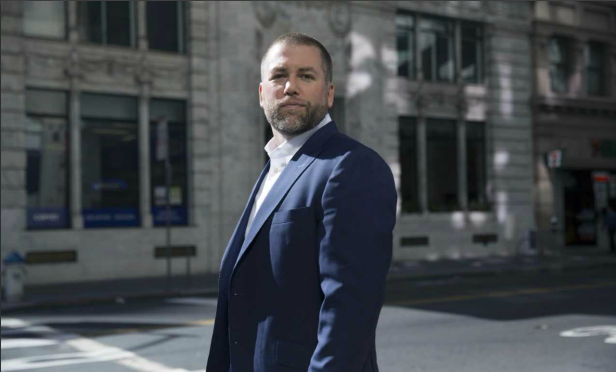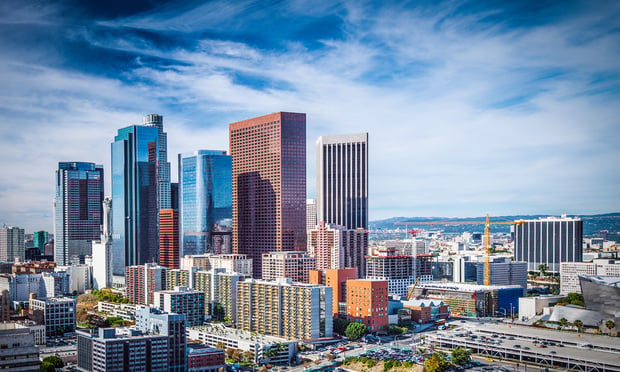 Amazon's city search for its second headquarters has the real estate investment community reeling. While many are taking bets on where the ecommerce giant will land, Downtown Los Angeles potentially checks all of the boxes on Amazon's—assumed—checklist. While no one is necessarily making bets on Downtown L.A., Mike Akerly, VP at Polaris Pacific, says that it could be a good fit, thanks to available office space, a robust housing pipeline and public transit. We sat down with Akerly for an exclusive interview to talk about the characteristics that Amazon needs in a (second) home city and why L.A. could fit the bill.
Amazon's city search for its second headquarters has the real estate investment community reeling. While many are taking bets on where the ecommerce giant will land, Downtown Los Angeles potentially checks all of the boxes on Amazon's—assumed—checklist. While no one is necessarily making bets on Downtown L.A., Mike Akerly, VP at Polaris Pacific, says that it could be a good fit, thanks to available office space, a robust housing pipeline and public transit. We sat down with Akerly for an exclusive interview to talk about the characteristics that Amazon needs in a (second) home city and why L.A. could fit the bill.
GlobeSt.com: What is Amazon looking for in a headquarter city?
Mike Akerly: Amazon needs someone that has a comprehensive plan to onboard such a major project. There are a number of things that they are going to be looking for, staring with a plan for or an existing pipeline of significant housing to accommodate 50,000 new residents, not to mention supporting industries that will end up following them there as well. They need someone with a comprehensive zoning plan that is going to accommodate all of that new building, and they need a city with a building approval process that is efficient and will allow this to happen in a reasonable period of time. You are going to need an already robust public transit system. That is going to be a major limiting factor in the 200-plus cities that would like to be part of this. They will also need major universities that have a track record of attracting in-stem type education, and even a K through 12 systems that is going to be funneling people into universities with STEM education. There are a lot of other things that are harder to quantify. For example, will they want a West Coast location that makes it easier for executives to get back-and-forth to Seattle, or do you expand to the East Coast where you expand to whole other group of people?
GlobeSt.com: What can cities do to make themselves more attractive to Amazon?
Akerly: There are a lot of gimmicky things that have been done, and those are intended to get the attention of the people reviewing the RFP process. The reality is that there is probably already a shortlist at Amazon of cities that they have identified could really work, and they are going to be looking to those particular municipalities to make an argument to them as to why they will culturally fit. If I was at Amazon, I would be looking for a city that appears to have the buy-in of the entire community. It is one thing for local city planners or politicians to offer tax incentives or other incentives, but the reality is that this isn't going to work in a 10 to 20 year timeframe unless the entire community wants this to happen. There are a lot of things that might be controversial in certain parts of the country, like the need for high-density housing. If you are going to have established residents fighting every time someone wants to put up an apartment building or raise height limits, that isn't going to work well. Or, if you can't get a transit bill passed or if you are going to raise sales taxes to fund hundreds of millions of dollars in transit expansion, like Los Angeles did, that isn't going to work well. You need to have a city that really wants to accommodate this growth on all fronts. Many of these cities will be changed radically over the course of 20 to 30 years.
GlobeSt.com: Do you have any predictions or opinions on a place that would be a good fit?
Akerly: I think Downtown Los Angeles is a really interesting underdog in all of this. It isn't a frontrunner but it makes sense in a lot of ways. You have 10,000 units of housing that will come to market in the next 2 to 3 years; a major revitalization of an existing housing stock; an existing office stock that could be used immediately; a public transportation system that is significantly evolved; a highly educated workforce; and USC and UCLA as well as regional schools. Plus, it is 2 and a half hours from Seattle by plane. I think it could make a lot of sense. If you have those major points in the pipeline and then you customize a plan for Amazon coming in, you'll be able to avoid some of the pitfalls. I think the city that wins is a city that will be able to say up front that we have already done this.
 Amazon's city search for its second headquarters has the real estate investment community reeling. While many are taking bets on where the ecommerce giant will land, Downtown Los Angeles potentially checks all of the boxes on Amazon's—assumed—checklist. While no one is necessarily making bets on Downtown L.A., Mike Akerly, VP at Polaris Pacific, says that it could be a good fit, thanks to available office space, a robust housing pipeline and public transit. We sat down with Akerly for an exclusive interview to talk about the characteristics that Amazon needs in a (second) home city and why L.A. could fit the bill.
Amazon's city search for its second headquarters has the real estate investment community reeling. While many are taking bets on where the ecommerce giant will land, Downtown Los Angeles potentially checks all of the boxes on Amazon's—assumed—checklist. While no one is necessarily making bets on Downtown L.A., Mike Akerly, VP at Polaris Pacific, says that it could be a good fit, thanks to available office space, a robust housing pipeline and public transit. We sat down with Akerly for an exclusive interview to talk about the characteristics that Amazon needs in a (second) home city and why L.A. could fit the bill.
GlobeSt.com: What is Amazon looking for in a headquarter city?
Mike Akerly: Amazon needs someone that has a comprehensive plan to onboard such a major project. There are a number of things that they are going to be looking for, staring with a plan for or an existing pipeline of significant housing to accommodate 50,000 new residents, not to mention supporting industries that will end up following them there as well. They need someone with a comprehensive zoning plan that is going to accommodate all of that new building, and they need a city with a building approval process that is efficient and will allow this to happen in a reasonable period of time. You are going to need an already robust public transit system. That is going to be a major limiting factor in the 200-plus cities that would like to be part of this. They will also need major universities that have a track record of attracting in-stem type education, and even a K through 12 systems that is going to be funneling people into universities with STEM education. There are a lot of other things that are harder to quantify. For example, will they want a West Coast location that makes it easier for executives to get back-and-forth to Seattle, or do you expand to the East Coast where you expand to whole other group of people?
GlobeSt.com: What can cities do to make themselves more attractive to Amazon?
Akerly: There are a lot of gimmicky things that have been done, and those are intended to get the attention of the people reviewing the RFP process. The reality is that there is probably already a shortlist at Amazon of cities that they have identified could really work, and they are going to be looking to those particular municipalities to make an argument to them as to why they will culturally fit. If I was at Amazon, I would be looking for a city that appears to have the buy-in of the entire community. It is one thing for local city planners or politicians to offer tax incentives or other incentives, but the reality is that this isn't going to work in a 10 to 20 year timeframe unless the entire community wants this to happen. There are a lot of things that might be controversial in certain parts of the country, like the need for high-density housing. If you are going to have established residents fighting every time someone wants to put up an apartment building or raise height limits, that isn't going to work well. Or, if you can't get a transit bill passed or if you are going to raise sales taxes to fund hundreds of millions of dollars in transit expansion, like Los Angeles did, that isn't going to work well. You need to have a city that really wants to accommodate this growth on all fronts. Many of these cities will be changed radically over the course of 20 to 30 years.
GlobeSt.com: Do you have any predictions or opinions on a place that would be a good fit?
Akerly: I think Downtown Los Angeles is a really interesting underdog in all of this. It isn't a frontrunner but it makes sense in a lot of ways. You have 10,000 units of housing that will come to market in the next 2 to 3 years; a major revitalization of an existing housing stock; an existing office stock that could be used immediately; a public transportation system that is significantly evolved; a highly educated workforce; and USC and UCLA as well as regional schools. Plus, it is 2 and a half hours from Seattle by plane. I think it could make a lot of sense. If you have those major points in the pipeline and then you customize a plan for Amazon coming in, you'll be able to avoid some of the pitfalls. I think the city that wins is a city that will be able to say up front that we have already done this.
Want to continue reading?
Become a Free ALM Digital Reader.
Once you are an ALM Digital Member, you’ll receive:
- Breaking commercial real estate news and analysis, on-site and via our newsletters and custom alerts
- Educational webcasts, white papers, and ebooks from industry thought leaders
- Critical coverage of the property casualty insurance and financial advisory markets on our other ALM sites, PropertyCasualty360 and ThinkAdvisor
Already have an account? Sign In Now
*May exclude premium content© 2024 ALM Global, LLC, All Rights Reserved. Request academic re-use from www.copyright.com. All other uses, submit a request to [email protected]. For more information visit Asset & Logo Licensing.








